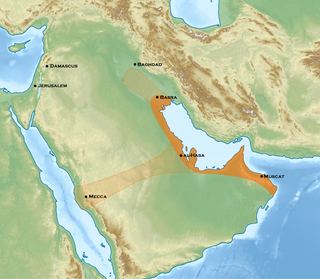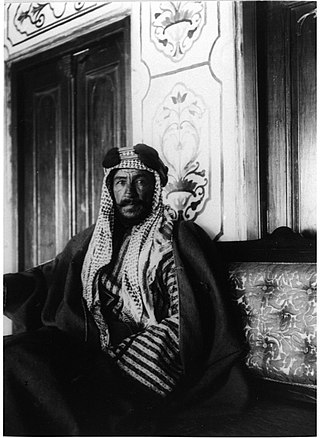Bahrain was a central location of the ancient Dilmun civilization. Bahrain's strategic location in the Persian Gulf has brought rule and influence from mostly the Persians, Sumerians, Assyrians, Babylonians, Portuguese, the Arabs, and the British.

The Qarmatians were a militant Isma'ili Shia movement centred in al-Hasa in Eastern Arabia, where they established a religious—and, as some scholars have claimed, proto-socialist or utopian socialist—state in 899 CE. Its members were part of a movement that adhered to a syncretic branch of Sevener Ismaili Shia Islam, and were ruled by a dynasty founded by Abu Sa'id al-Jannabi, a Persian from Jannaba in coastal Fars. They rejected the claim of Fatimid Caliph Abdallah al-Mahdi Billah to imamate and clung to their belief in the coming of the Mahdi, and they revolted against the Fatimid and Abbasid Caliphates.
Frank Holmes, known affectionately by Arabs as "Abu Naft", was a British-New Zealand mining engineer, geologist and oil concession hunter. Following distinguished service in World War I, he was granted the title of honorary Major and was thereafter known as Major Frank Holmes in his civilian life.

Sheikh Mubarak Al-Sabah "the Great", nicknamed "The lion of the peninsula", was the seventh ruler of the Sheikhdom of Kuwait, from 18 May 1896 until his death on 18 November 1915. Mubarak ascended the throne upon killing his half-brother, Muhammad Al-Sabah. Known for his significant role in shaping modern Kuwait, the constitution of the State of Kuwait mandates that the Emir of Kuwait must be a descendant of Mubarak from the ruling Al-Sabah family.

Eastern Arabia (Bahrain), is a region stretched from Basra to Khasab along the Persian Gulf coast and included parts of modern-day Bahrain, Kuwait, Iraq, Eastern Saudi Arabia, United Arab Emirates, Qatar, Oman. The entire coastal strip of Eastern Arabia was known as "Bahrain" for a millennium.

Bani Khalid is an Arab tribal confederation mainly inhabiting the Arabian Peninsula. The tribe ruled southern Iraq, Kuwait, and Eastern Arabia from the 15th century to the 18th century, and again under the auspices of the Ottoman Empire during the early 19th century. At its greatest extent, the domain of Bani Khalid extended from Iraq in the north to the borders of Oman in the South, and Bani Khalid wielded political influence by ruling the region of Najd in central Arabia. Most of the tribe's members presently reside in eastern and central Saudi Arabia, while others live in Iraq, Kuwait, Qatar, Bahrain, Syria and the United Arab Emirates. Bani Khalid has both Shia Muslim and Sunni Muslim members.
Sheikh Nasr Al-Madhkur was the 18th-century Arab governor from a Huwala clan under Karim Khan Zand of the Zand dynasty of what was described by a contemporary account as an "independent state" in Bushehr and Bahrain. The account by German geographer Carsten Niebuhr who visited the region at the time describes Sheikh Nasr as "the sole Monarch of the Isle of Bahrain”. A “mutashayi’”, Sheikh Nasr lost Bahrain - which was inhabited by his Shi’a compatriots - in 1783 after his defeat by the Bani Utbah tribal alliance at Zubarah in 1782.

Marzouq Ali Mohammed Al-Ghanim is a former speaker of the Kuwaiti National Assembly, representing the second district. Al-Ghanim earned a BSc in mechanical engineering from Seattle University and worked for Boubyan Petrochemical Company before being elected to the National Assembly in 2006. He is the son of Ali al-Ghanim and Faiza al-Kharafi. He was elected Speaker in 2013.
This is the order of battle for Operation Badr, an Egyptian military operation that initiated the Yom Kippur War against Israel along the Suez Canal in the Sinai on October 6, 1973. As neither belligerent has released an official order of battle, this list remains incomplete and largely conjectural. An asterisk indicates Egyptian units that participated in the operation.
Al-Dhafeer is an ancient Arabian tribe, that goes back to Tayy. It used to control the entirety of the Najd region of the Arabian Peninsula from around 1300 to 1590 AD. They were known as warriors of the Arabian region 700 years ago, united and always together despite their huge numbers. Starting in the 1300s, Al-Dhafeer resided around Medina, close to Mecca. Now most of the tribe lives in Kingdom of Saudi Arabia taking positions such as professors, politicians, scholars, doctors and engineers. They also live in Kuwait, United Arab Emirates, Bahrain, Iraq, Jordan, and Qatar.

The Sheikhdom of Kuwait was a sheikhdom during the pre-oil era. The sheikhdom became a British protectorate between 1899 and 1961 following the Anglo-Kuwaiti agreement of 1899. This agreement was made between Sheikh Mubarak Al-Sabah and the British Government in India, primarily as a defensive measure against threats from the Ottoman Empire. After 1961, the sheikdom became the state of Kuwait.
The Uyunid dynasty were an Arab dynasty that ruled Eastern Arabia for 163 years, from the 11th to the 13th centuries. Their sect were Shia. They were, like the majority of the people of Eastern Arabia, from the Banu Abdul Qays tribe. They seized the country from the Qarmatians with the military assistance of Great Seljuq Empire in the year 1077–1078 CE. It then fell to the Usfurids of Banu Uqayl in 651 AH. The famous poet Ali bin al Mugrab Al Uyuni is a Uyunid.
The Second Field Army is a military formation of the Egyptian Army, formed in 1968. Army headquarters is at Ismailia. It is usually commanded by a field commander of lieutenant-general rank of at least 34 years' service, and reports directly to the Army General Headquarters and General Staff.
The following is a timeline of the history of Kuwait City, Al Asimah Governorate, Kuwait, and its metro surroundings.

Bani Khalid Emirate or the Emirate of Al Humaid from the Bani Khalid tribe was a state that arose in the eastern region of the Arabian Peninsula in year 1669 after Emir Barrak ibn Ghurayr made his capital in Al-Mubarraz then managed to defeat the Ottoman Empire represented by Lahsa Eyalet and drove them out of the region. The Emirate of Al Hamid ended in the year 1796 after the defeat of Barak bin Abdul Mohsen at the hands of the First Saudi State.
Sheikh Mohammed bin Khalifa bin Faisal Al Jumaili Al Khalifa Al Thalabi ibn Wa'il (Arabic: الأمير محمد بن خليفة بن فيصل الجميلي التغلبي الوائلي, was an Emir of Qatar and founder of the city of Zubarah as well as a founding ancestor of the House of Khalifa. Al Jumaili was born his tribe’s original hometown of Al-Hadar, a village in the Al-Aflaj Province of the Riyadh Region of Saudi Arabia, south of Najd. From there he moved to Kuwait and then to Qatar, where he ruled from 1765 until his death in 1773.





